International College Portsmouth Pre-Master's Research Methods Exam
VerifiedAdded on 2022/12/09
|7
|1712
|461
Homework Assignment
AI Summary
This document presents a comprehensive solution to a research methods examination. Section A addresses key concepts such as positivistic and phenomenological methodologies, exploring their advantages and types. It also delves into questionnaire design, including different question types like multiple-choice, rating scales, Likert scales, and open-ended questions, while also highlighting the advantages and disadvantages of both open and closed questions. Section B further elaborates on the validity and reliability of research, emphasizing the importance of questionnaire design and ethical considerations, including deception, right to withdrawal, and protection of participants. The document also discusses sampling strategies, differentiating between probability and non-probability sampling methods. Finally, it analyzes the benefits of 1:1 interviews in modern business research, emphasizing their role in data collection and understanding consumer behavior.

Assessment
Paraphrase This Document
Need a fresh take? Get an instant paraphrase of this document with our AI Paraphraser
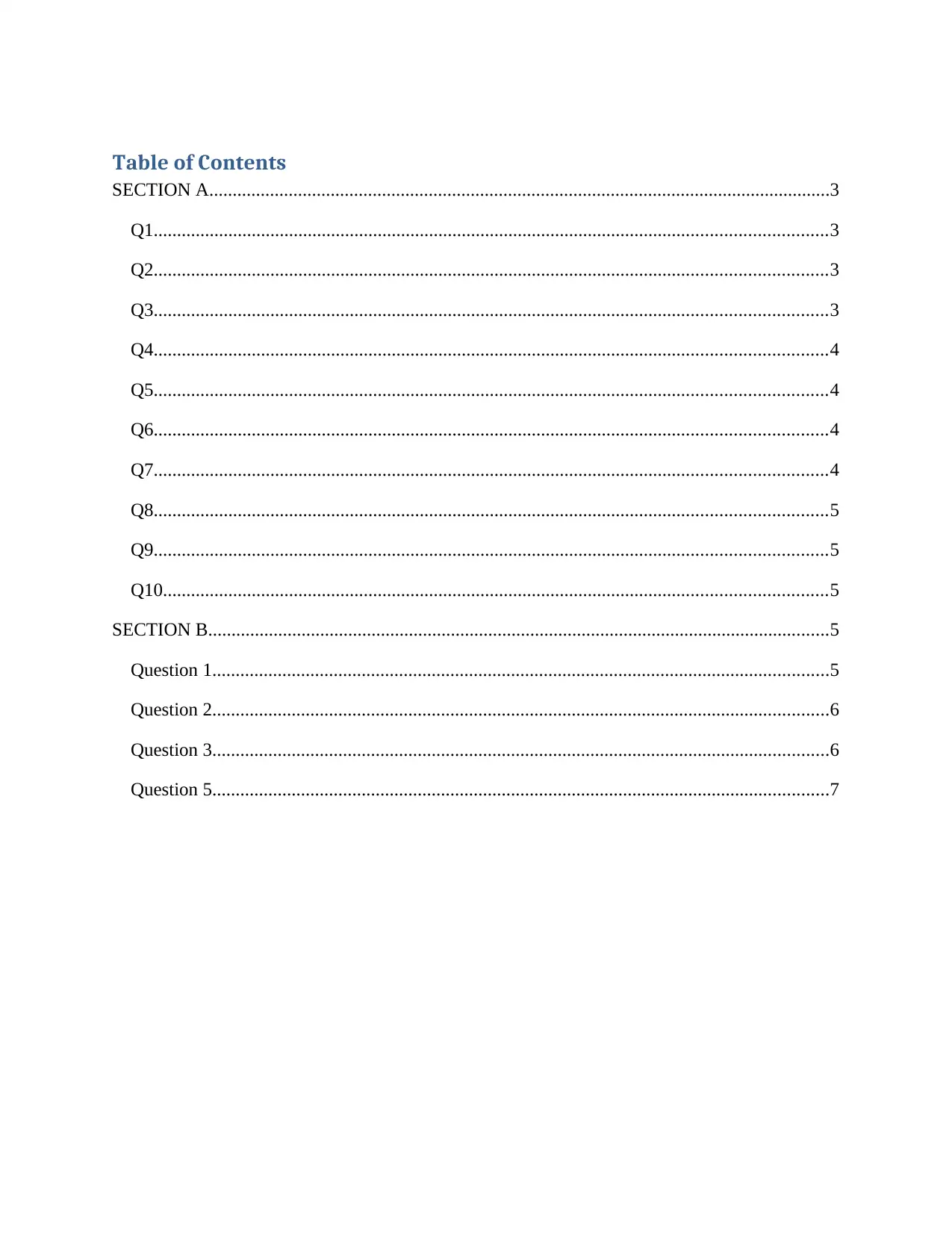
Table of Contents
SECTION A.....................................................................................................................................3
Q1................................................................................................................................................3
Q2................................................................................................................................................3
Q3................................................................................................................................................3
Q4................................................................................................................................................4
Q5................................................................................................................................................4
Q6................................................................................................................................................4
Q7................................................................................................................................................4
Q8................................................................................................................................................5
Q9................................................................................................................................................5
Q10..............................................................................................................................................5
SECTION B.....................................................................................................................................5
Question 1....................................................................................................................................5
Question 2....................................................................................................................................6
Question 3....................................................................................................................................6
Question 5....................................................................................................................................7
SECTION A.....................................................................................................................................3
Q1................................................................................................................................................3
Q2................................................................................................................................................3
Q3................................................................................................................................................3
Q4................................................................................................................................................4
Q5................................................................................................................................................4
Q6................................................................................................................................................4
Q7................................................................................................................................................4
Q8................................................................................................................................................5
Q9................................................................................................................................................5
Q10..............................................................................................................................................5
SECTION B.....................................................................................................................................5
Question 1....................................................................................................................................5
Question 2....................................................................................................................................6
Question 3....................................................................................................................................6
Question 5....................................................................................................................................7
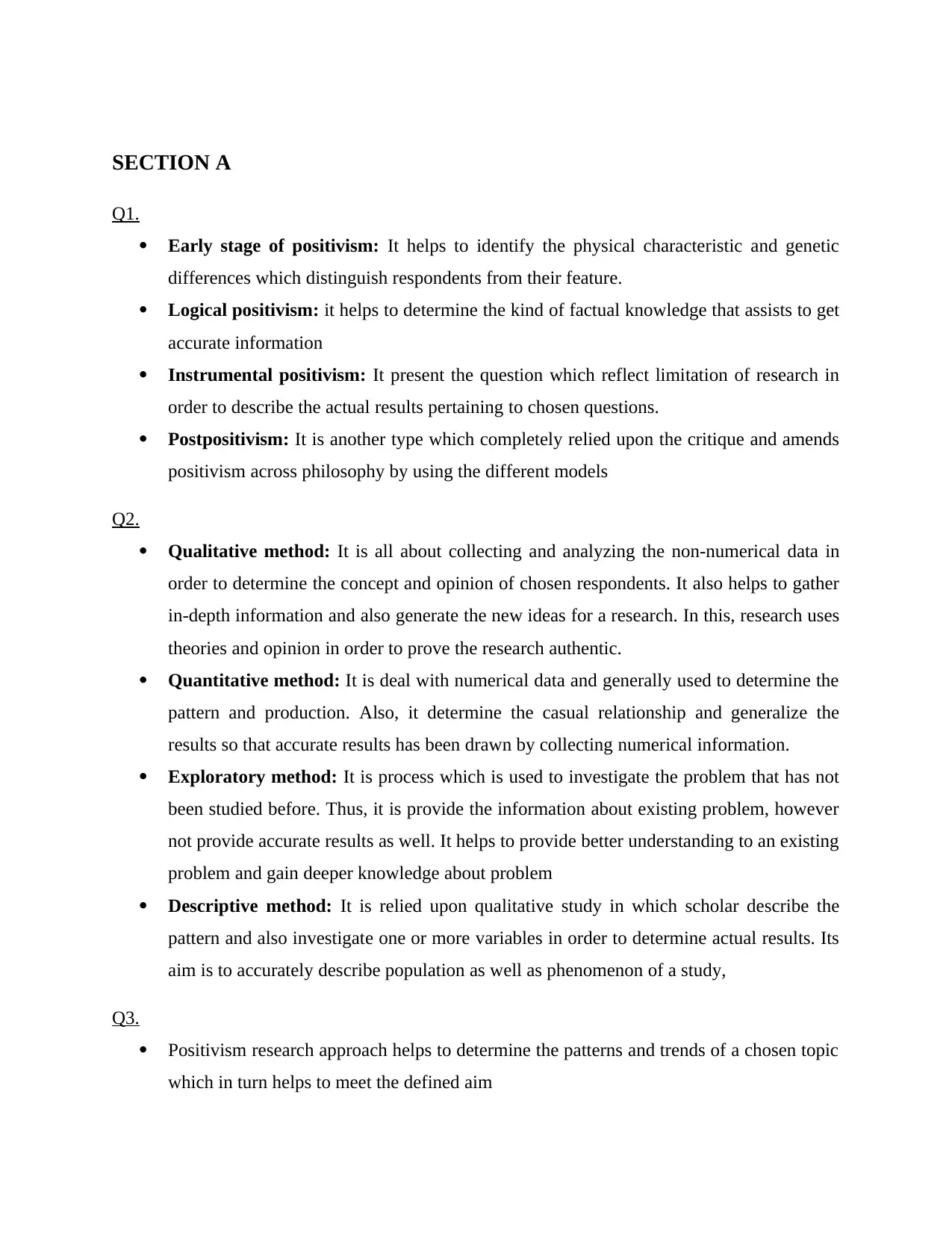
SECTION A
Q1.
Early stage of positivism: It helps to identify the physical characteristic and genetic
differences which distinguish respondents from their feature.
Logical positivism: it helps to determine the kind of factual knowledge that assists to get
accurate information
Instrumental positivism: It present the question which reflect limitation of research in
order to describe the actual results pertaining to chosen questions.
Postpositivism: It is another type which completely relied upon the critique and amends
positivism across philosophy by using the different models
Q2.
Qualitative method: It is all about collecting and analyzing the non-numerical data in
order to determine the concept and opinion of chosen respondents. It also helps to gather
in-depth information and also generate the new ideas for a research. In this, research uses
theories and opinion in order to prove the research authentic.
Quantitative method: It is deal with numerical data and generally used to determine the
pattern and production. Also, it determine the casual relationship and generalize the
results so that accurate results has been drawn by collecting numerical information.
Exploratory method: It is process which is used to investigate the problem that has not
been studied before. Thus, it is provide the information about existing problem, however
not provide accurate results as well. It helps to provide better understanding to an existing
problem and gain deeper knowledge about problem
Descriptive method: It is relied upon qualitative study in which scholar describe the
pattern and also investigate one or more variables in order to determine actual results. Its
aim is to accurately describe population as well as phenomenon of a study,
Q3.
Positivism research approach helps to determine the patterns and trends of a chosen topic
which in turn helps to meet the defined aim
Q1.
Early stage of positivism: It helps to identify the physical characteristic and genetic
differences which distinguish respondents from their feature.
Logical positivism: it helps to determine the kind of factual knowledge that assists to get
accurate information
Instrumental positivism: It present the question which reflect limitation of research in
order to describe the actual results pertaining to chosen questions.
Postpositivism: It is another type which completely relied upon the critique and amends
positivism across philosophy by using the different models
Q2.
Qualitative method: It is all about collecting and analyzing the non-numerical data in
order to determine the concept and opinion of chosen respondents. It also helps to gather
in-depth information and also generate the new ideas for a research. In this, research uses
theories and opinion in order to prove the research authentic.
Quantitative method: It is deal with numerical data and generally used to determine the
pattern and production. Also, it determine the casual relationship and generalize the
results so that accurate results has been drawn by collecting numerical information.
Exploratory method: It is process which is used to investigate the problem that has not
been studied before. Thus, it is provide the information about existing problem, however
not provide accurate results as well. It helps to provide better understanding to an existing
problem and gain deeper knowledge about problem
Descriptive method: It is relied upon qualitative study in which scholar describe the
pattern and also investigate one or more variables in order to determine actual results. Its
aim is to accurately describe population as well as phenomenon of a study,
Q3.
Positivism research approach helps to determine the patterns and trends of a chosen topic
which in turn helps to meet the defined aim
⊘ This is a preview!⊘
Do you want full access?
Subscribe today to unlock all pages.

Trusted by 1+ million students worldwide
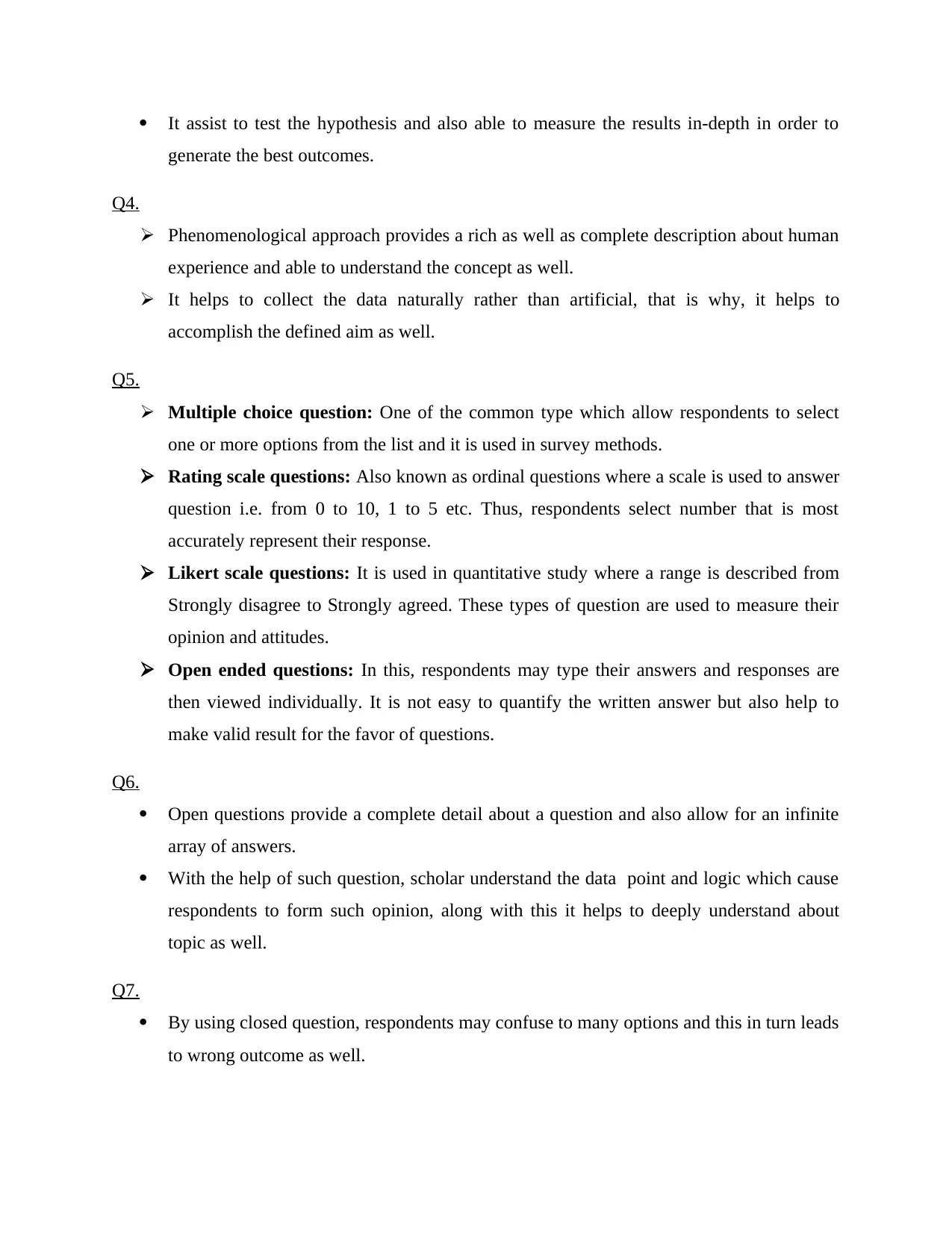
It assist to test the hypothesis and also able to measure the results in-depth in order to
generate the best outcomes.
Q4.
Phenomenological approach provides a rich as well as complete description about human
experience and able to understand the concept as well.
It helps to collect the data naturally rather than artificial, that is why, it helps to
accomplish the defined aim as well.
Q5.
Multiple choice question: One of the common type which allow respondents to select
one or more options from the list and it is used in survey methods.
Rating scale questions: Also known as ordinal questions where a scale is used to answer
question i.e. from 0 to 10, 1 to 5 etc. Thus, respondents select number that is most
accurately represent their response.
Likert scale questions: It is used in quantitative study where a range is described from
Strongly disagree to Strongly agreed. These types of question are used to measure their
opinion and attitudes.
Open ended questions: In this, respondents may type their answers and responses are
then viewed individually. It is not easy to quantify the written answer but also help to
make valid result for the favor of questions.
Q6.
Open questions provide a complete detail about a question and also allow for an infinite
array of answers.
With the help of such question, scholar understand the data point and logic which cause
respondents to form such opinion, along with this it helps to deeply understand about
topic as well.
Q7.
By using closed question, respondents may confuse to many options and this in turn leads
to wrong outcome as well.
generate the best outcomes.
Q4.
Phenomenological approach provides a rich as well as complete description about human
experience and able to understand the concept as well.
It helps to collect the data naturally rather than artificial, that is why, it helps to
accomplish the defined aim as well.
Q5.
Multiple choice question: One of the common type which allow respondents to select
one or more options from the list and it is used in survey methods.
Rating scale questions: Also known as ordinal questions where a scale is used to answer
question i.e. from 0 to 10, 1 to 5 etc. Thus, respondents select number that is most
accurately represent their response.
Likert scale questions: It is used in quantitative study where a range is described from
Strongly disagree to Strongly agreed. These types of question are used to measure their
opinion and attitudes.
Open ended questions: In this, respondents may type their answers and responses are
then viewed individually. It is not easy to quantify the written answer but also help to
make valid result for the favor of questions.
Q6.
Open questions provide a complete detail about a question and also allow for an infinite
array of answers.
With the help of such question, scholar understand the data point and logic which cause
respondents to form such opinion, along with this it helps to deeply understand about
topic as well.
Q7.
By using closed question, respondents may confuse to many options and this in turn leads
to wrong outcome as well.
Paraphrase This Document
Need a fresh take? Get an instant paraphrase of this document with our AI Paraphraser
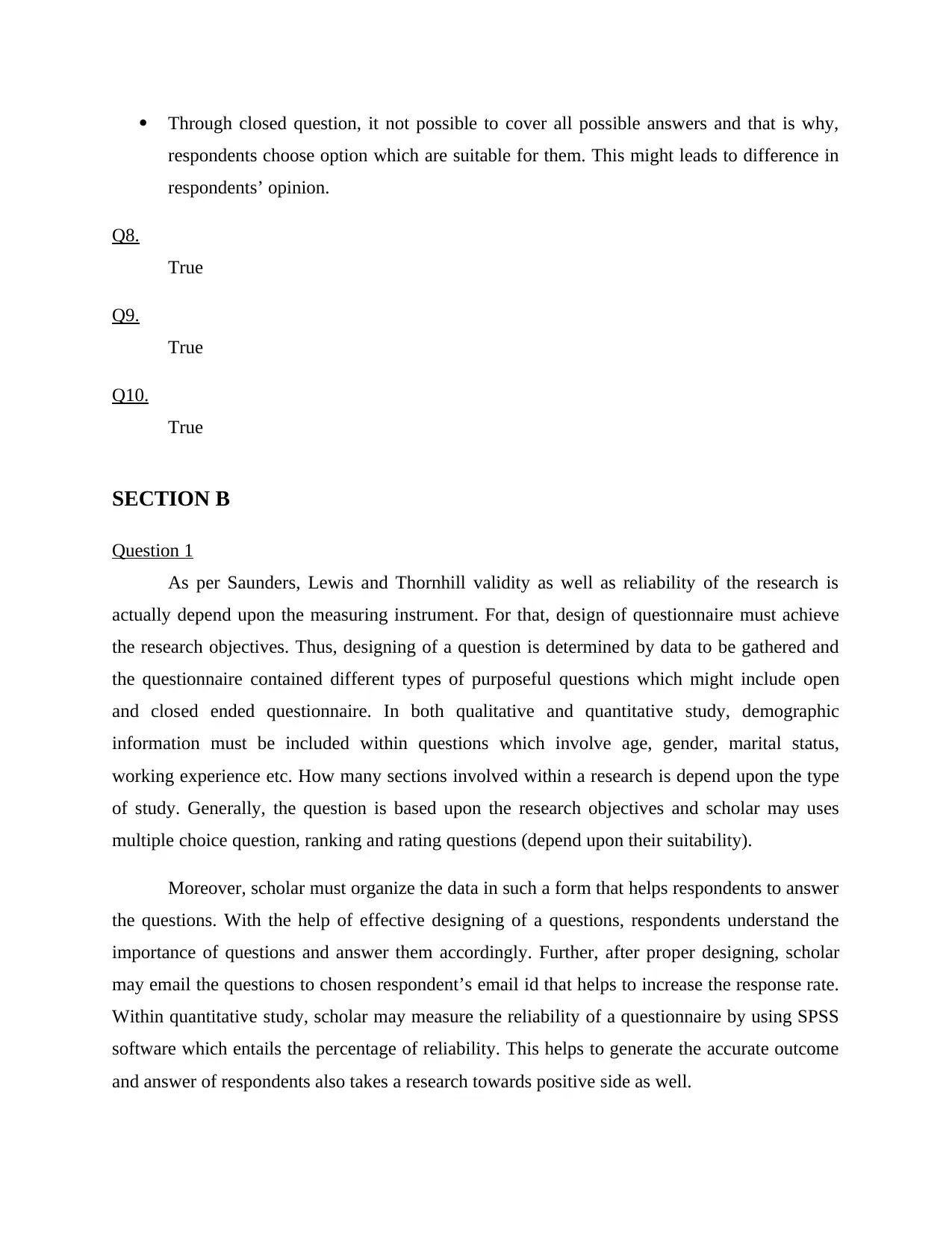
Through closed question, it not possible to cover all possible answers and that is why,
respondents choose option which are suitable for them. This might leads to difference in
respondents’ opinion.
Q8.
True
Q9.
True
Q10.
True
SECTION B
Question 1
As per Saunders, Lewis and Thornhill validity as well as reliability of the research is
actually depend upon the measuring instrument. For that, design of questionnaire must achieve
the research objectives. Thus, designing of a question is determined by data to be gathered and
the questionnaire contained different types of purposeful questions which might include open
and closed ended questionnaire. In both qualitative and quantitative study, demographic
information must be included within questions which involve age, gender, marital status,
working experience etc. How many sections involved within a research is depend upon the type
of study. Generally, the question is based upon the research objectives and scholar may uses
multiple choice question, ranking and rating questions (depend upon their suitability).
Moreover, scholar must organize the data in such a form that helps respondents to answer
the questions. With the help of effective designing of a questions, respondents understand the
importance of questions and answer them accordingly. Further, after proper designing, scholar
may email the questions to chosen respondent’s email id that helps to increase the response rate.
Within quantitative study, scholar may measure the reliability of a questionnaire by using SPSS
software which entails the percentage of reliability. This helps to generate the accurate outcome
and answer of respondents also takes a research towards positive side as well.
respondents choose option which are suitable for them. This might leads to difference in
respondents’ opinion.
Q8.
True
Q9.
True
Q10.
True
SECTION B
Question 1
As per Saunders, Lewis and Thornhill validity as well as reliability of the research is
actually depend upon the measuring instrument. For that, design of questionnaire must achieve
the research objectives. Thus, designing of a question is determined by data to be gathered and
the questionnaire contained different types of purposeful questions which might include open
and closed ended questionnaire. In both qualitative and quantitative study, demographic
information must be included within questions which involve age, gender, marital status,
working experience etc. How many sections involved within a research is depend upon the type
of study. Generally, the question is based upon the research objectives and scholar may uses
multiple choice question, ranking and rating questions (depend upon their suitability).
Moreover, scholar must organize the data in such a form that helps respondents to answer
the questions. With the help of effective designing of a questions, respondents understand the
importance of questions and answer them accordingly. Further, after proper designing, scholar
may email the questions to chosen respondent’s email id that helps to increase the response rate.
Within quantitative study, scholar may measure the reliability of a questionnaire by using SPSS
software which entails the percentage of reliability. This helps to generate the accurate outcome
and answer of respondents also takes a research towards positive side as well.
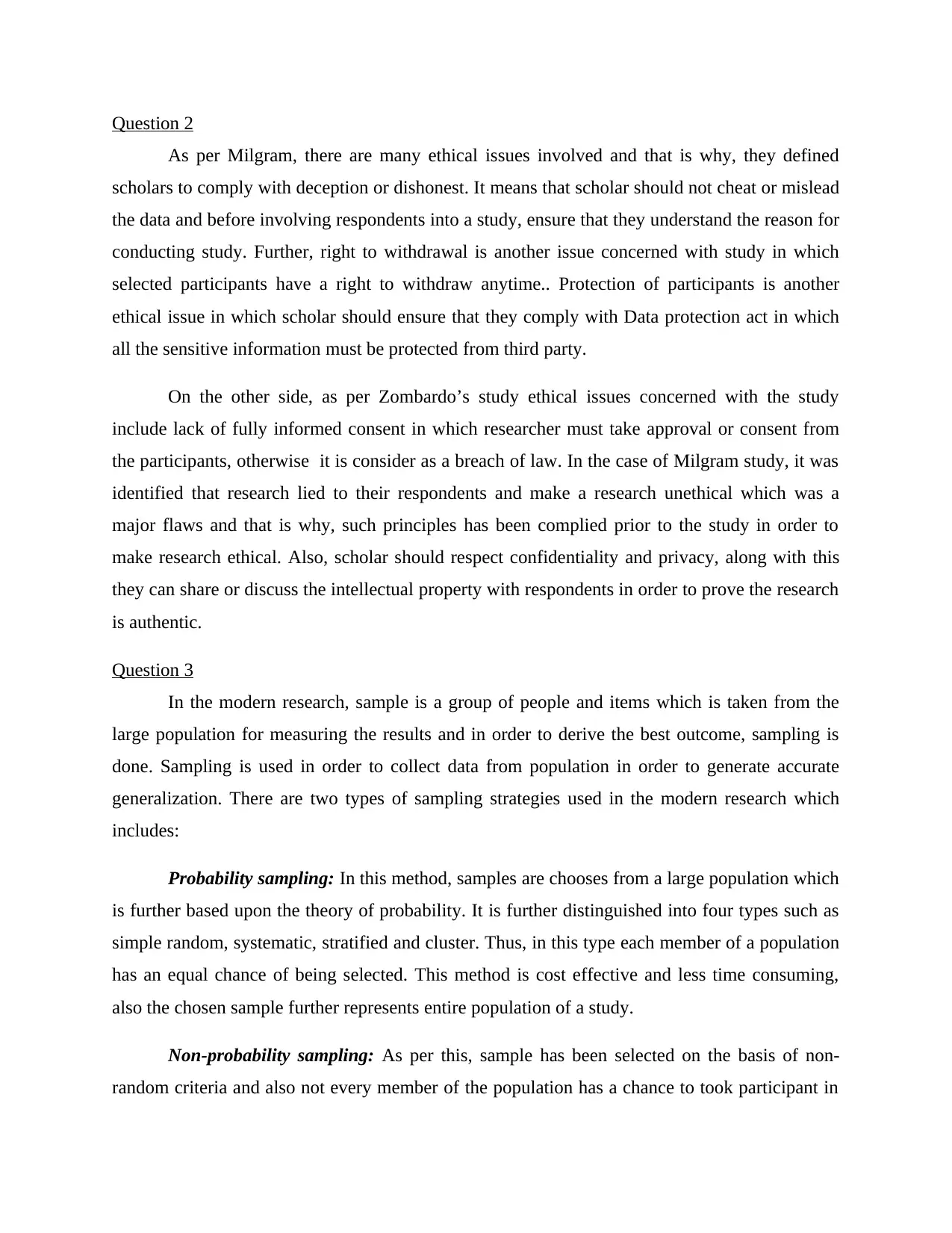
Question 2
As per Milgram, there are many ethical issues involved and that is why, they defined
scholars to comply with deception or dishonest. It means that scholar should not cheat or mislead
the data and before involving respondents into a study, ensure that they understand the reason for
conducting study. Further, right to withdrawal is another issue concerned with study in which
selected participants have a right to withdraw anytime.. Protection of participants is another
ethical issue in which scholar should ensure that they comply with Data protection act in which
all the sensitive information must be protected from third party.
On the other side, as per Zombardo’s study ethical issues concerned with the study
include lack of fully informed consent in which researcher must take approval or consent from
the participants, otherwise it is consider as a breach of law. In the case of Milgram study, it was
identified that research lied to their respondents and make a research unethical which was a
major flaws and that is why, such principles has been complied prior to the study in order to
make research ethical. Also, scholar should respect confidentiality and privacy, along with this
they can share or discuss the intellectual property with respondents in order to prove the research
is authentic.
Question 3
In the modern research, sample is a group of people and items which is taken from the
large population for measuring the results and in order to derive the best outcome, sampling is
done. Sampling is used in order to collect data from population in order to generate accurate
generalization. There are two types of sampling strategies used in the modern research which
includes:
Probability sampling: In this method, samples are chooses from a large population which
is further based upon the theory of probability. It is further distinguished into four types such as
simple random, systematic, stratified and cluster. Thus, in this type each member of a population
has an equal chance of being selected. This method is cost effective and less time consuming,
also the chosen sample further represents entire population of a study.
Non-probability sampling: As per this, sample has been selected on the basis of non-
random criteria and also not every member of the population has a chance to took participant in
As per Milgram, there are many ethical issues involved and that is why, they defined
scholars to comply with deception or dishonest. It means that scholar should not cheat or mislead
the data and before involving respondents into a study, ensure that they understand the reason for
conducting study. Further, right to withdrawal is another issue concerned with study in which
selected participants have a right to withdraw anytime.. Protection of participants is another
ethical issue in which scholar should ensure that they comply with Data protection act in which
all the sensitive information must be protected from third party.
On the other side, as per Zombardo’s study ethical issues concerned with the study
include lack of fully informed consent in which researcher must take approval or consent from
the participants, otherwise it is consider as a breach of law. In the case of Milgram study, it was
identified that research lied to their respondents and make a research unethical which was a
major flaws and that is why, such principles has been complied prior to the study in order to
make research ethical. Also, scholar should respect confidentiality and privacy, along with this
they can share or discuss the intellectual property with respondents in order to prove the research
is authentic.
Question 3
In the modern research, sample is a group of people and items which is taken from the
large population for measuring the results and in order to derive the best outcome, sampling is
done. Sampling is used in order to collect data from population in order to generate accurate
generalization. There are two types of sampling strategies used in the modern research which
includes:
Probability sampling: In this method, samples are chooses from a large population which
is further based upon the theory of probability. It is further distinguished into four types such as
simple random, systematic, stratified and cluster. Thus, in this type each member of a population
has an equal chance of being selected. This method is cost effective and less time consuming,
also the chosen sample further represents entire population of a study.
Non-probability sampling: As per this, sample has been selected on the basis of non-
random criteria and also not every member of the population has a chance to took participant in
⊘ This is a preview!⊘
Do you want full access?
Subscribe today to unlock all pages.

Trusted by 1+ million students worldwide
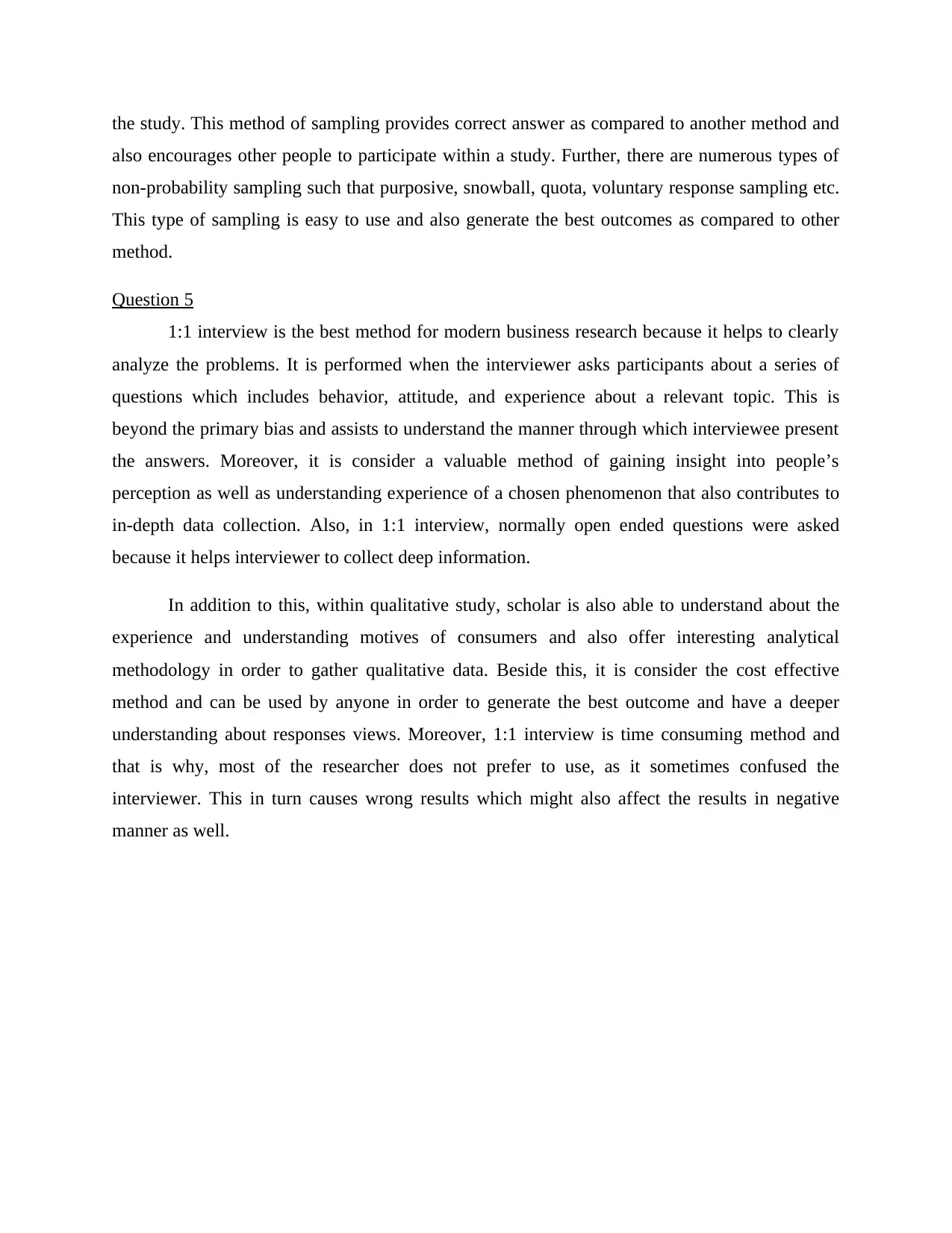
the study. This method of sampling provides correct answer as compared to another method and
also encourages other people to participate within a study. Further, there are numerous types of
non-probability sampling such that purposive, snowball, quota, voluntary response sampling etc.
This type of sampling is easy to use and also generate the best outcomes as compared to other
method.
Question 5
1:1 interview is the best method for modern business research because it helps to clearly
analyze the problems. It is performed when the interviewer asks participants about a series of
questions which includes behavior, attitude, and experience about a relevant topic. This is
beyond the primary bias and assists to understand the manner through which interviewee present
the answers. Moreover, it is consider a valuable method of gaining insight into people’s
perception as well as understanding experience of a chosen phenomenon that also contributes to
in-depth data collection. Also, in 1:1 interview, normally open ended questions were asked
because it helps interviewer to collect deep information.
In addition to this, within qualitative study, scholar is also able to understand about the
experience and understanding motives of consumers and also offer interesting analytical
methodology in order to gather qualitative data. Beside this, it is consider the cost effective
method and can be used by anyone in order to generate the best outcome and have a deeper
understanding about responses views. Moreover, 1:1 interview is time consuming method and
that is why, most of the researcher does not prefer to use, as it sometimes confused the
interviewer. This in turn causes wrong results which might also affect the results in negative
manner as well.
also encourages other people to participate within a study. Further, there are numerous types of
non-probability sampling such that purposive, snowball, quota, voluntary response sampling etc.
This type of sampling is easy to use and also generate the best outcomes as compared to other
method.
Question 5
1:1 interview is the best method for modern business research because it helps to clearly
analyze the problems. It is performed when the interviewer asks participants about a series of
questions which includes behavior, attitude, and experience about a relevant topic. This is
beyond the primary bias and assists to understand the manner through which interviewee present
the answers. Moreover, it is consider a valuable method of gaining insight into people’s
perception as well as understanding experience of a chosen phenomenon that also contributes to
in-depth data collection. Also, in 1:1 interview, normally open ended questions were asked
because it helps interviewer to collect deep information.
In addition to this, within qualitative study, scholar is also able to understand about the
experience and understanding motives of consumers and also offer interesting analytical
methodology in order to gather qualitative data. Beside this, it is consider the cost effective
method and can be used by anyone in order to generate the best outcome and have a deeper
understanding about responses views. Moreover, 1:1 interview is time consuming method and
that is why, most of the researcher does not prefer to use, as it sometimes confused the
interviewer. This in turn causes wrong results which might also affect the results in negative
manner as well.
1 out of 7
Related Documents
Your All-in-One AI-Powered Toolkit for Academic Success.
+13062052269
info@desklib.com
Available 24*7 on WhatsApp / Email
![[object Object]](/_next/static/media/star-bottom.7253800d.svg)
Unlock your academic potential
Copyright © 2020–2025 A2Z Services. All Rights Reserved. Developed and managed by ZUCOL.





